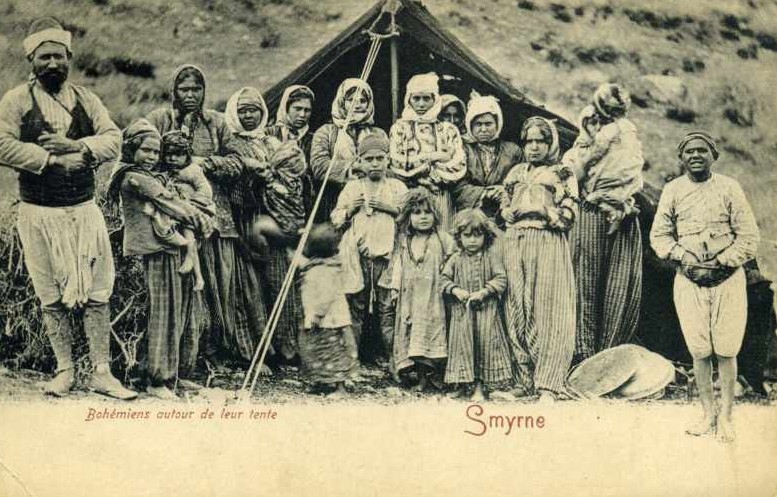In 18th century Europe, Jews were accused of abducting children (blond, blue eyed, Christians) and using their blood for the baking of matzos during Passover. This “Blood Libel” and a litany of heinous myths fueled the anti-Semitic tradition that culminated in the various pogroms and mass slaughter of Jews during World War Two. The plight of the Jews is not unfamiliar to the American and European general public.
Just this past week, a young girl with blond hair, blue eyes, and a pale complexion was purportedly abducted. But it wasn’t Jews who were accused of the crime — it was Gypsies. Her discovery sparked outrage and drew coverage from the international media. Four-year-old Maria was promptly dubbed the “Blond Angel” and plastered across headlines as a lost angelic child, found in the arms of a dark Gypsy couple. Discovered living in a Roma settlement in Greece, authorities scrambled to find Maria’s real parents and save her from the Roma who claimed her as their own.
As demonstrated by the global outcry over Maria, there is an insidious underlying sense of Romani degeneracy still held by authorities and our overall cultural psyche. The Romani people, commonly labeled Gypsies (although the word is increasingly considered pejorative), faced a similar range of historical accusations and persecutions, and yet seems to be an afterthought in our collective shame of Jewish persecution. The common motif of Roma as kidnappers and economic “leeches” is unnervingly reminiscent of Jewish discrimination. But unlike the Jews, prejudice against the Roma has hardly abated since World War Two and is still almost official policy in many parts of Europe. They remain silent victims of social and economic prejudice and exclusion.

Though the suspected abduction of any child warrants public alarm, the scope of the outrage over Maria is undoubtedly linked to the historical and ethnic underpinnings of this case. The search for Maria’s parents and the nature of her Roma ‘abductors’ has been covered all around the world. Meanwhile, the “Blond Angel” is a Roma after all, and the couple was in fact given the child by Maria’s mother, who could no longer afford to support her. The initial suspicion of abduction from the police is not entirely unfounded, as she does look physically distinctive from her brothers and sisters. However, this fits in all-too-neatly with the historical myths of Romani kidnapping white children, not to mention that it sets a tenuous precedent for racial profiling.
The series of reactions in Ireland, for example, actualize these concerns. The day after Maria’s discovery made news, two children in Ireland were removed from their Roma parents, given DNA tests, and held overnight by police. This information was deemed valid by the police because a journalist had received a Facebook message from a random civilian stating that “There is also little girl living in a Roma house in Tallaght and she is blond and blue eyed,” and who went on to make racist comments about Romas. A separate tip-off from a member of the public led to a two-year-old boy being taken and held overnight for a DNA test — he too had fairer features than his family. Despite the parents producing a passport and birth certificate, cops took the child away.
The journalist who reported on this backlash in Ireland drew an evocative comparison: “Imagine if a black family in Greece were suspected of child abduction and this suspicion alone was enough to prompt police investigations into other black families in Ireland. That is how absurd this is.”
This is but the latest instance in a series of racial profiling of the Roma and further discrimination throughout Europe. In what’s been deemed the “summer of hate,” 2013 marked a deluge of relentless and hateful rhetoric and violent hate crimes against the Roma. Of the approximately 10 million Roma living in Europe, the largest concentration is found in Eastern countries. They make up 10 percent of the population in Bulgaria, 9 percent in Slovakia, 8 percent in Romania and 7 percent in Hungary. Since those countries joined the EU, many Roma have moved west to Italy, France, Germany, and Spain. Their presence has been systematically and overtly scorned in each of these places – with the only measurable motive being the poverty that brought them there in the first place.
European governments continue to actively discriminate against the Roma. One in three Roma in Europe are unemployed and 90% live below the poverty line. European Romani often subsist in ramshackle settlements, and are denied both employment opportunities and medical treatment because of their ethnicity. It is unsurprising, then, that the average European lives over ten years longer than a Roma. And the discrimination doesn’t stop with adults, as Romani children have been forced into schools for disabled children, even when they have no mental or physical disabilities.
So where does this blatant exclusion and discrimination stem from? And why has it been so normalized in our society and media?
Centuries of inhabiting European countries have not eroded Roma cultural traditions, as most have always lived on outskirts and travelled in nomadic communities. Though there have been various speculations over the past seven centuries concerning the Romani origin, a growing body of evidence, drawing on linguistic tracing and genetics, points to India as the Romani people’s ancestral homeland. For centuries after their arrival in Europe, the Roma were respected as a skilled immigrant group, often working as metal craftsman, musicians, and soldiers. It was not long before the Roma were used as scapegoats for various social grievances, and began to face persecution and threats. Roma in the Balkans had their civil liberties stripped away until they were ultimately seized and forced into slavery, a practice that persisted for five hundred years, into the mid-1800s. Those fortunate enough to remain free were persecuted and excluded from European society, always forced to remain on the move. As many Roma continue to live in travelling groups, the widespread notion that they simply prefer this lifestyle should not be used to dismiss their plight – many simply cannot find a way to settle down. What is clear is that the historical origin of their nomadic lifestyle lies in in their discrimination; like Jews, the Roma often were prohibited from buying land or entering more stable occupations.
There is a recognized phrase to commemorate the Jewish holocaust: “Never forget.” Were we ever even taught about “Porajmos?” Let’s make room for the remembrance of Romani persecution and end its insidious legacy that continues today.

Very good article, but one very big mistake. When generalizing about the Roma today, you CANNOT refer to us as nomadic. The majority of us, the majority in the Balkans and across Europe ARE NOT NOMADIC nor have we been for 300 years, or inthe case of Istanbul, we have settled in one neighborhood for over 800 years, until that neighborhood was destroyed in 2012. 800 years of not being nomadic, but yes, living on the outskirts of towns, like the shtetls.
thank you for clarifying this- apologies!